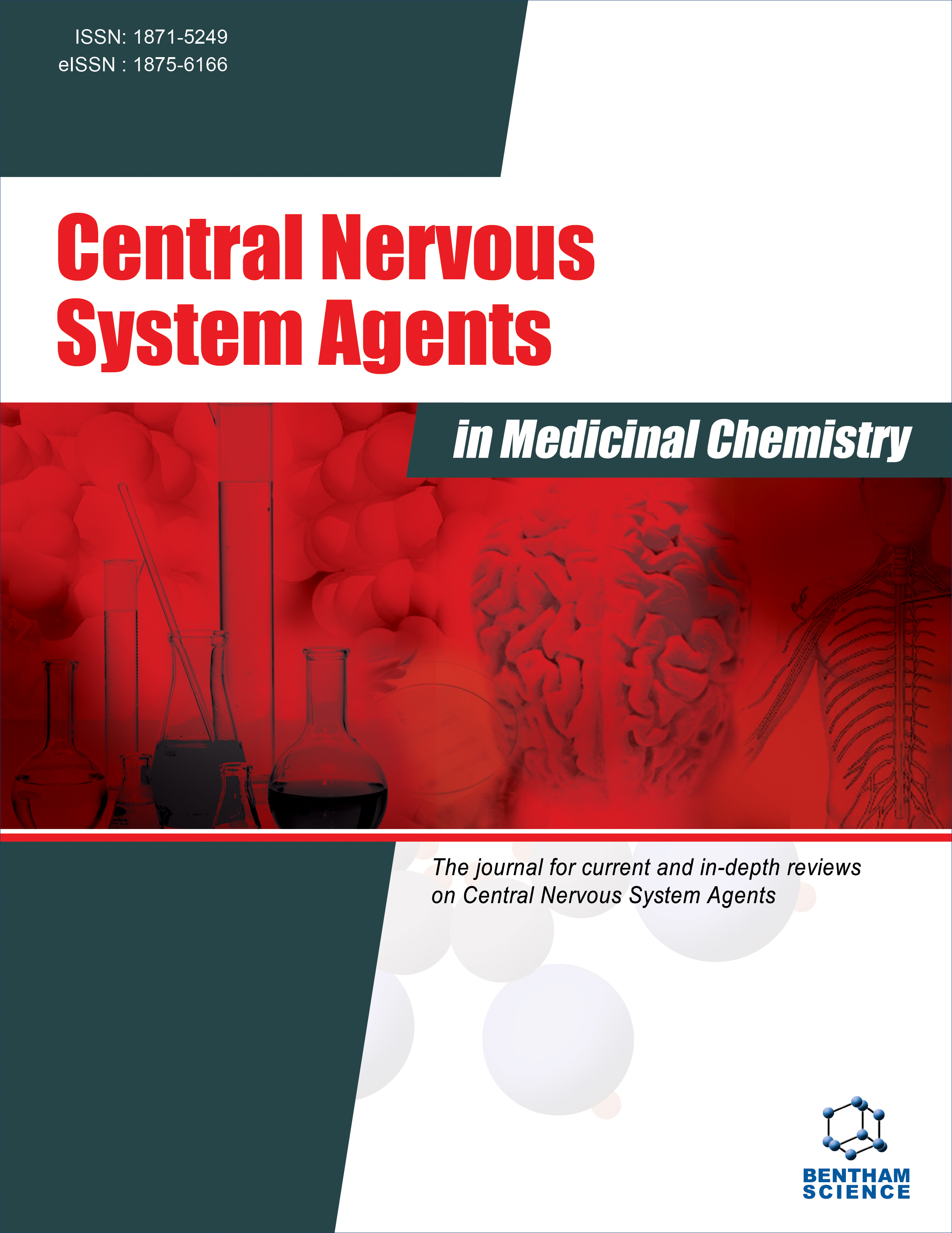- Home
- A-Z Publications
- Central Nervous System Agents in Medicinal Chemistry (Formerly Current Medicinal Chemistry - Central Nervous System Agents)
- Previous Issues
- Volume 15, Issue 1, 2015
Central Nervous System Agents in Medicinal Chemistry (Formerly Current Medicinal Chemistry - Central Nervous System Agents) - Volume 15, Issue 1, 2015
Volume 15, Issue 1, 2015
-
-
Pyrimidine Derivatives as Potential Agents Acting on Central Nervous System
More LessAuthors: Sanjiv Kumar, Aakash Deep and Balasubramanian NarasimhanPyrimidine and its derivatives are present in many of the bioactive aromatic compounds that are of wide interest because of their diverse biological and clinical applications. The utility of pyrimidines as synthon for various biologically active compounds has given impetus to these studies. The review article aims to review the work reported on pharmacological activities of central nervous system (CNS) such as anticonvulsant an Read More
-
-
-
Anticonvulsant and Neurological Profile of Benzothiazoles: A Mini-Review
More LessAuthors: Jagbir Gagoria, Prabhakar Kumar Verma and Anurag KhatkarFrom last few years research work on heterocyclic compound and their derivatives has been increasing. Benzothiazole molecule has a heterocyclic structure, basic in nature with wide variety of active sites. As a small molecule, it contains electronegative atoms due to which it is feasible for other moieties to form conjugates. Referring to the bioorganic and medicinal chemistry, the moiety has potential to give active pharmacophor Read More
-
-
-
1,2,4-Triazole Derivatives as Potential Scaffold for Anticonvulsant Activity
More LessAuthors: Vipan K. Kamboj, Prabhakar K. Verma, Anu Dhanda and Sudhir RanjanThe search for new anticonvulsant agent with more selectivity and lower toxicity continues to be an area of rigorous investigation in medicinal chemistry. Epilepsy is a chronic disorder of brain whose treatment consists of controlling seizures with antiepileptic drugs that very often related with side-effects which in rare circumstances can be potentially life-threatening. Triazolam and Alprazolam are established drugs used in Read More
-
-
-
Thiazolidin-4-one Derivatives as Central Nervous System Potential Agents
More LessAuthors: Davinder Kumar, Virender Kumar, Jyoti Mundlia, Deepak Pradhan and Sandeep MalikA heterocyclic compound is one which possesses a cyclic structure with at least two different kinds of hetero atoms in the ring. Nitrogen, oxygen, and sulphur are the most common heteroatoms. Derivatives are an important class of heterocyclic compounds and play a vital role due to their wide range of biological activities and industrial importance. 4-Thiazolidinones have always been an attraction point for researchers bec Read More
-
-
-
A Mini Review on Central Nervous System Potential of Isatin Derivatives
More LessAuthors: Priyanka Phogat and Pritam SinghIsatin is a heterocyclic moiety which can be used for the synthesis of a large variety of heterocyclic compounds such as quinolines, indoles and as raw material for medicinal important drugs. This review gives an overview of the advances of isatin for the synthesis of various heterocyclic compounds and shows the various biological potentials such as anticonvulsant, sedative, hypnotic, monoamine oxidase inhibitors, antian Read More
-
-
-
Beyond Mitochondria, What Would be the Energy Source of the Cell?
More LessCurrently, cell biology is based on glucose as the main source of energy. Cellular bioenergetic pathways have become unnecessarily complex in their eagerness to explain that how the cell is able to generate and use energy from the oxidation of glucose, where mitochondria play an important role through oxidative phosphorylation. During a descriptive study about the three leading causes of blindness in the world, th Read More
-
-
-
Diazenyl Derivatives as Therapeutic and Diagnostic Agents Acting on Central Nervous System
More LessAuthors: Harmeet Kaur, Snehlata Yadav and Balasubramanian NarasimhanIn last decade, the development of new drugs and drug products for central nervous system (CNS) has remained limited due to incomplete elucidation of pathophysiology of many CNS disorders, complexity of the diseases and the lack of technologies for delivery through the blood-brain barrier (BBB). In this article we will summarize the development of diazenyl derivatives of many biologically active moieties like benzodia Read More
-
-
-
Fragment-based Designing for the Generation of Novel Leads Against BACE1
More LessAuthors: Sucharita Das, Sandipan Chakraborty and Soumalee BasuBACE1, the aspartate protease that generates amyloid-β peptide (Aβ) in the brain of AD (Alzheimer’s disease) patients, has emerged as a pharmaceutically relevant target. Here, a fragment-based in silico approach has been adopted to design novel compounds with increased ligand efficiency for BACE1, before screening for brain permeability and toxicity. Fragments docked to the active site of BACE1 and sorted into t Read More
-
Volumes & issues
-
Volume 25 (2025)
-
Volume 24 (2024)
-
Volume 23 (2023)
-
Volume 22 (2022)
-
Volume 21 (2021)
-
Volume 20 (2020)
-
Volume 19 (2019)
-
Volume 18 (2018)
-
Volume 17 (2017)
-
Volume 16 (2016)
-
Volume 15 (2015)
-
Volume 14 (2014)
-
Volume 13 (2013)
-
Volume 12 (2012)
-
Volume 11 (2011)
-
Volume 10 (2010)
-
Volume 9 (2009)
-
Volume 8 (2008)
-
Volume 7 (2007)
-
Volume 6 (2006)
Most Read This Month
Article
content/journals/cnsamc
Journal
10
5
false
en


